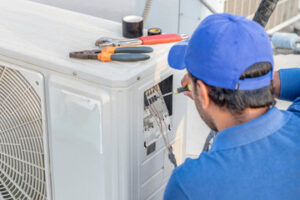AIR CONDITIONING INSTALLATION MILFORD OH is an investment in your home. It should be done properly to ensure that the system provides measurable value and improves your quality of life.

Air conditioning professionals are trained to do more than simply place the system in a spot and plug it in. A proper installation includes plumbing, electricity and infrastructure work.
The cost of air conditioning installation varies depending on the type and size of equipment you choose. Window units are less expensive, while split systems and central air conditioners have higher installation costs. Additionally, premium brands offer advanced features that may require specialized installation procedures, which can drive up the overall price of your system. In addition, installing an air conditioning unit in an older building or one with complex ductwork can increase labor and materials costs.
When choosing an installer, look for ones that are affiliated with reputable air conditioner brands. These brands hold their contractors to high standards and provide warranty-backed parts and labor. Additionally, they should have a physical address so you can contact them if there are any issues.
You should also make sure your installer is licensed and insured, as this protects you from any potential problems. In addition, they should be certified by the Environmental Protection Agency (EPA) to handle refrigerants. This is an important step to ensure your new air conditioning system is installed properly and is up to code.
Another factor that influences the cost of air conditioning installation is the size and capacity of the system you need. A larger AC will cool a larger space more effectively, but it will also cost more to operate. You can minimize your cost by selecting an energy-efficient model with a lower SEER rating.
A quality air conditioner can improve your health, productivity, comfort, and home value, but it’s crucial to have it installed properly by a qualified professional. During the installation process, the professional should explain the operation of your new air conditioner and answer any questions you have. They should also recommend regular maintenance services to keep your system working at its best.
During the installation process, the professionals will need to establish a drainage path for the indoor and outdoor units. This will prevent water damage and maintain indoor air quality. They’ll also need to connect the unit to your electrical system, which should be done by a licensed electrician.
Energy Efficiency
The energy efficiency of air conditioning is the ratio of cooling power to electricity used to run it. It is often compared to the efficiency of a light bulb and is expressed as an energy-efficiency rating (EER or SEER). The higher the EER, the more efficient the unit. Energy-efficient systems also reduce air pollution and greenhouse gas emissions. They are more environmentally friendly than conventional models and typically use fewer refrigerants, which do not harm the ozone layer. Air conditioning systems account for a significant percentage of peak power demand in some countries and generate considerable carbon dioxide emissions. Energy-efficient technologies can reduce air conditioning-related CO2 emissions by up to 40% (IEA 2008).
Whether or not your old AC system needs replacing, upgrading it to an energy-efficient model can help lower your utility bills and protect the environment. If you want to save even more money, ask your local energy company about rebates. They may offer incentives for installing more energy-efficient ACs.
Newer, more efficient air conditioners consume 30% to 50% less energy than older models, saving you money on energy costs and improving your home’s environmental footprint. In addition, you can save even more by upgrading your insulation and reducing air leaks. Air-sealing retrofits can reduce cooling energy usage by another 15%.
Choosing an experienced and qualified air conditioning contractor is critical to ensuring that your system operates efficiently. Look for a professional who is licensed and insured, and has extensive experience with your type of air conditioning system. They should also be able to recommend the best solution to meet your specific requirements. Also, be sure to ask for references from previous clients and check their credentials online. Finally, don’t be afraid to get a second opinion!
Installation
Professional air conditioner installation is a complex process that involves a lot of steps. Before the technicians arrive, you should clear the area where they will work and make sure that all necessary equipment is available. You should also turn off the power to avoid any accidents or injuries. The technicians will test the system to ensure that it meets your needs. They will also double-check all connections and make sure that everything works correctly.
If you have a new split system, the installation process usually begins with installing the indoor unit and then the outdoor unit. Once the units are in place, the installers will connect them using piping and electrical wiring. This process can take up to an hour and a half.
The installers will also prepare the window area by cleaning it and removing any obstacles. They will then drill holes in the wall to feed piping through it. They will then use expanding polyurethane foam to seal the holes in the walls. The foam will ensure that the piping and cables don’t move around or become disconnected.
You can choose to have your new air conditioning system installed with either a cased coil or an uncased coil. The former is a coil with an insulated cabinet, while the latter is a simple coil. Both options have their advantages and disadvantages, so it is important to discuss your preferences with the company before choosing a type.
Most new air conditioners are mounted high on a wall. In addition to mounting the unit, the technicians will install brackets and ensure that it is securely fastened to the wall. If you live in a condo or co-op building, your landlord or management may have specific policies that dictate the types of brackets and hardware to be used. Ensure that the installers are aware of these requirements before booking an appointment. They should also discuss any concerns or preferences you might have regarding the location of the indoor and outdoor units.
Maintenance
An air conditioning system is an investment, and it’s important to make sure the new installation is a good fit for your home. That’s why professional air conditioning installation teams custom-fit metal ductwork, and carefully connect refrigerant piping to ensure that all components work together to meet the manufacturer’s specifications. This prevents future problems and extends the life of your system.
Once the ductwork is installed, installers focus on the outdoor unit. They choose a location that is suitable for the size of your unit and install a rubber isolation pad beneath it to reduce vibration and noise. They then set the compressor unit in place and level it to avoid movement. Then, they connect the copper line sets to the service valve. They use a filler rod to seal the connections, making them leak-free.
Finally, they remove the fan cage or fan grill and clean the inside of the coils (evaporator and condenser). They also inspect the exterior compressor unit for damage. Before working on the outside unit, technicians shut off power to it by closing the exterior shut-off box and turning off the breaker in your house. Lastly, they clean debris and leaves off the unit. They may also clean the interior of the fan cage or grill with a wet/dry vacuum.

